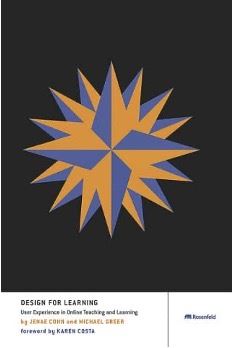Publication Details
| OLOR Series: | OLOR Reviews |
| Author(s): | Sarah Kosel Agnihotri |
| Original Publication Date: | 29 November 2023 |
| Permalink: |
<gsole.org/olor/reviews/2023.11.29> |
Resource Overview
Media, Figures, Tables |
Resource Contents
Editor's Note
We present this review with deep regard for Michael Greer who passed away in September 2023. A founding member of GSOLE, Michael was esteemed and loved by GSOLE. It is our honor to offer our comments on his last publication, hoping that what we say here will celebrate the breadth, scope, and influence of his final contribution. The GSOLE community will miss Michael.
Review of Design for Learning: User Experience in Online Teaching and Learning
In Design for Learning: User Experience in Online Teaching and Learning, Jenae Cohn and Michael Greer guide readers through fundamentals of design principles for creating accessible, engaging online learning experiences. The tone is conversational and direct, striking a balance that will appeal to novice as well as expert audiences, and the organization of the book makes it easy to navigate in multiple ways depending on readers’ goals. While the intended audience is faculty involved in the design and development of online learning experiences, literacy educators will likely appreciate the many examples Cohn and Greer include related to online writing instruction, as well as the emphasis on User Experience writing strategies. With section outlines opening each of the 11 chapters and “Takeaways” summarizing the key points at the end, enhanced by links throughout the book to relevant information covered in more depth elsewhere, it can be used as a quick reference when searching for specific information or it can be read through as a step-by-step guide.
Early in the text, Cohn and Greer orient readers to the concept of learning experience design and provide a model for how this approach informs online course development. They weave together information from UX research, learning science, instructional design, and other fields to ground the reader in how to design for learning by leveraging the tools uniquely suited for that task. Explaining that “[l]earners do not absorb knowledge; they actively create new knowledge” (p. 23), the authors add that “[b]eing online means taking advantage of a whole cluster of tools to ensure that the space is aligned well with the experiences” (p. 63). They guide the reader through the iterative steps of an intentional design process that maximizes the affordances of technology and online learning spaces.
After establishing the theoretical grounding of their subject, Cohn and Greer detail the technical aspects of implementation. Chapters 1-3 focus on learning about learners, demonstrating how to build on those insights to align instructional goals with a learner-centered approach. Chapters 4-7 cover processes for designing text and producing instructional videos for an online course. Chapters 8-9 suggest strategies for fostering learner engagement, and Chapters 10-11 offer advice on collecting feedback for continuous improvement of the learning experience. Each chapter is packed with information, presented in manageable chunks with a focus on actionable steps that reduce any overwhelm a learning designer might feel.
Whether the goal is to design an online course for the first time, redesign an established course, explore ways to incorporate online learning strategies into hybrid environments, or just retool as an experienced online instructor, this book is invaluable. The authors write, “As a learner-centered designer, your goal is to make the pathway to learner success as smooth as possible. Bad learning design should not be a barrier...” (p. 52). This is the ethos of the whole book, focused on designing learning experiences that at every opportunity elevate the goal of good learning and center trust in learners. I found myself excited and re-energized by the advice in each chapter, while recognizing that this text would be a fantastic resource for new learning designers as well.
As someone with a background in writing education, my favorite section of the book was Chapter 5, “Designing Texts,” which focused attention on the role of text in an online course. The authors made explicit how text serves as a key element of the learning design, while also offering clear instructions on how to do it well, explaining, “Text forms the backbone of the online learning experience. Words are the connection to your learners” (p. 65).
Design for Learning is practical, realistic, and empathetic, acknowledging that faculty want to design the best possible learning experiences while also recognizing that such a task involves an amount of work and time that can be difficult to manage in addition to myriad other responsibilities. The authors do not compromise on their standards for high quality, accessible design practices, yet invite their readers along with kindness and enthusiasm for the work. Towards the end of the book, they encourage their readers to, “...be kind to yourself and be compassionate about the work you are doing…trust that if you come into the work with a caring mindset, you will create a meaningful learning environment” (pp. 130-131).
Acknowledging that the process can feel messy and imperfect, they add, “When you’re working and responding with real people, things will never go quite as you expect. Embrace the change and have fun connecting with other humans!” This is what makes Designing for Learning particularly special in a sea of books on learning design for online courses: the authors invite readers into the process, celebrating and empathizing with them through all the challenges and triumphs of mapping out a course, designing and developing the learning experiences, evaluating feedback, and iterating for continued improvement.
Design for Learning: User Experience in Online Teaching and Learning.
Jenae Cohn and Michael Greer. 2023. Rosenfield Media. [paperback + ebook, $49.99; ebook only, $38.99]
About the Reviewer
Sarah Kosel Agnihotri, MA TESOL, is an education specialist at Wayne State University and has previously worked as a writing center coordinator and adjunct writing instructor. She is currently pursuing graduate coursework in Learning Design and Technology at WSU to further her interest in learning experience design.



